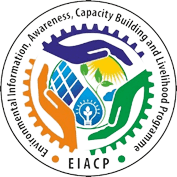Bibliography
- Chandrashekar, V.D., Shetty, A. Trends in extreme rainfall over ecologically sensitive Western
Ghats and coastal regions of Karnataka: an observational assessment. Arab J Geosci 11, 327
(2018). https://doi.org/10.1007/s12517-018-3700-6
- Ramachandra, T.V., Bharath, S., Subash Chandran, M.D. et al. Salient Ecological Sensitive
Regions of Central Western Ghats, India. Earth Syst Environ 2, 15–34 (2018). https://doi.org/10.1007/s41748-018-0040-3
- Vandana, M., John, S.E., Maya, K. et al. Environmental impact of quarrying of building stones
and laterite blocks: a comparative study of two river basins in Southern Western Ghats, India.
Environ Earth Sci 79, 366 (2020). https://doi.org/10.1007/s12665-020-09104-1
- Satyanarayana, J., Reddy, L.A.K., Kulshrestha, M.J. et al. Chemical composition of rain water
and influence of airmass trajectories at a rural site in an ecological sensitive area of Western
Ghats (India). J Atmos Chem 66, 101–116 (2010). https://doi.org/10.1007/s10874-011-9193-2
- Naik, D., Rao, R.S.P., Kunte, K. et al. Seasonal dynamics and polyphenism of butterfly
communities in the coastal plains of central Western Ghats, India. J Biosci 47, 79 (2022). https://doi.org/10.1007/s12038-022-00316-0
- Naik, D., Rao, R.S.P., Kunte, K. et al. Ecological monitoring and indicator taxa: butterfly
communities in heterogeneous landscapes of the Western Ghats and Malabar coast, India. J Insect
Conserv 26, 107–119 (2022). https://doi.org/10.1007/s10841-022-00368-5
- Gopinath, G., Jesiya, N., Achu, A.L. et al. Ensemble of fuzzy-analytical hierarchy process in
landslide susceptibility modeling from a humid tropical region of Western Ghats, Southern India.
Environ Sci Pollut Res (2023). https://doi.org/10.1007/s11356-023-27377-4
- Ghare, U., Narvekar, S., Lodha, T. et al. Bacterial Communities and Diversity of Western Ghats
Soil: A Study of a Biodiversity Hotspot. Curr Microbiol 80, 108 (2023). https://doi.org/10.1007/s00284-023-03207-1
- Shivaprakash, K.N., Ramesh, B.R., Umashaanker, R. et al. Functional trait and community
phylogenetic analyses reveal environmental filtering as the major determinant of assembly of
tropical forest tree communities in the Western Ghats biodiversity hotspot in India. For.
Ecosyst. 5, 25 (2018). https://doi.org/10.1186/s40663-018-0144-0
- Tiwari, V.M., Ajayakumar Varma, R. & Padmalal, D. Workshop on Western Ghats: Evolution and
environmental issues. J Geol Soc India 88, 811–812 (2016). https://doi.org/10.1007/s12594-016-0549-8
- Chandu, N., Eldho, T.I. & Mondal, A. Hydrological impacts of climate and land-use change in
Western Ghats, India. Reg Environ Change 22, 32 (2022). https://doi.org/10.1007/s10113-022-01879-2
- Jha, S., Bharti, B., Reddy, D.V. et al. Assessment of climate warming in the Western Ghats of
India in the past century using geothermal records. Theor Appl Climatol 142, 453–465
(2020). https://doi.org/10.1007/s00704-020-03321-1
- Ramachandra, T.V., Setturu, B., Rajan, K.S. et al. Modelling the forest transition in Central
Western Ghats, India. Spat. Inf. Res. 25, 117–130 (2017). https://doi.org/10.1007/s41324-017-0084-8
- Sharannya, T.M., Venkatesh, K., Mudbhatkal, A. et al. Effects of land use and climate change on
water scarcity in rivers of the Western Ghats of India. Environ Monit Assess 193, 820 (2021). https://doi.org/10.1007/s10661-021-09598-7
- Bodare, S., Ravikanth, G., Ismail, S.A. et al. Fine- and local- scale genetic structure of
Dysoxylum malabaricum, a late-successional canopy tree species in disturbed forest patches
in the Western Ghats, India. Conserv Genet 18, 1–15 (2017). https://doi.org/10.1007/s10592-016-0877-7
- Hegde, N., Joosten, H. The impact of traditional conservation practices on species composition
and diversity patterns of sacred swamps in the central Western Ghats, India. Wetlands Ecol
Manage 31, 245–266 (2023). https://doi.org/10.1007/s11273-023-09914-7
- Hegde, N., Ziegler, R., Greiser, C. et al. A preliminary assessment of landscape features and
cultural practices of sacred fresh water swamps in the central Western Ghats, India. Wetlands
Ecol Manage 26, 49–61 (2018). https://doi.org/10.1007/s11273-017-9553-z
- Magesh, N.S., Chandrasekar, N. & Soundranayagam, J.P. Morphometric evaluation of Papanasam
and Manimuthar watersheds, parts of Western Ghats, Tirunelveli district, Tamil Nadu, India: a
GIS approach. Environ Earth Sci 64, 373–381 (2011). https://doi.org/10.1007/s12665-010-0860-4
- Magesh, N.S., Jitheshlal, K.V., Chandrasekar, N. et al. GIS based morphometric evaluation of
Chimmini and Mupily watersheds, parts of Western Ghats, Thrissur District, Kerala, India. Earth
Sci Inform 5, 111–121 (2012). https://doi.org/10.1007/s12145-012-0101-3
- Abe, G., Erinjery Joseph, J. Changes in streamflow regime due to anthropogenic regulations in
the humid tropical Western Ghats, Kerala State, India. J. Mt. Sci. 12, 456–470 (2015). https://doi.org/10.1007/s11629-013-2764-8
- Das, S., Singh, T.P. Forest Type, Diversity and Biomass Estimation in Tropical Forests of
Western Ghat of Maharashtra Using Geospatial Techniques. Small-scale Forestry 15, 517–532
(2016). https://doi.org/10.1007/s11842-016-9337-y
- Ramachandra, T.V., Bharath, S. & Bharath, A.H. Insights of Forest Dynamics for the Regional
Ecological Fragility Assessment. J Indian Soc Remote Sens 48, 1169–1189 (2020). https://doi.org/10.1007/s12524-020-01146-z
- Sundar, S., Silva, D.P., de Oliveira Roque, F. et al. Predicting climate effects on aquatic true
bugs in a tropical biodiversity hotspot. J Insect Conserv 25, 229–241 (2021). https://doi.org/10.1007/s10841-021-00298-8
- Singh, J.S., Roy, P.S., Murthy, M.S.R. et al. Application of landscape ecology and remote
sensing for assessment, monitoring and conservation of biodiversity. J Indian Soc Remote Sens
38, 365–385 (2010). https://doi.org/10.1007/s12524-010-0033-7
- Shukla, R., Chakraborty, A. & Joshi, P.K. Vulnerability of agro-ecological zones in India
under the earth system climate model scenarios. Mitig Adapt Strateg Glob Change 22,
399–425 (2017). https://doi.org/10.1007/s11027-015-9677-5
- Abraham, M.T., Satyam, N. & Pradhan, B. Forecasting Landslides Using Mobility Functions: A
Case Study from Idukki District, India. Indian Geotech J 51, 684–693 (2021). https://doi.org/10.1007/s40098-020-00490-8
- Mikhailov, V.O., Arora, K., Ponomarev, A.V. et al. Reservoir induced seismicity in the
Koyna–Warna region, India: Overview of the recent results and hypotheses. Izv., Phys.
Solid Earth 53, 518–529 (2017). https://doi.org/10.1134/S1069351317030041
- Ramesh, V.V.S., Thampi, S.G. Application of hydrologic and hydraulic methods to calculate the
environmental flow requirements of the Chaliyar river. Environ Earth Sci 82, 166 (2023). https://doi.org/10.1007/s12665-023-10850-1
- Retnamma, J., Sarath, S., Balachandran, K.K. et al. Environmental and human facets of the
waterweed proliferation in a Vast Tropical Ramsar Wetland-Vembanad Lake System. Environ Monit
Assess 195, 900 (2023). https://doi.org/10.1007/s10661-023-11417-0
- T V, R., Setturu, B. & Chandran, S. Geospatial analysis of forest fragmentation in Uttara
Kannada District, India. For. Ecosyst. 3, 10 (2016). https://doi.org/10.1186/s40663-016-0069-4
- Abraham, M.T., Satyam, N., Reddy, S.K.P. et al. Runout modeling and calibration of friction
parameters of Kurichermala debris flow, India. Landslides 18, 737–754 (2021). https://doi.org/10.1007/s10346-020-01540-1
- Buchunde, P., Safai, P.D., Mukherjee, S. et al. Characterisation of particulate matter at a
high-altitude site in southwest India: Impact of dust episodes. J Earth Syst Sci 128, 237
(2019). https://doi.org/10.1007/s12040-019-1265-8
- Abraham, A., Kundapura, S. Spatio-temporal Dynamics of Land Use Land Cover Changes and Future
Prediction Using Geospatial Techniques. J Indian Soc Remote Sens 50, 2175–2191 (2022). https://doi.org/10.1007/s12524-022-01588-7
- Raj, A., Sharma, L.K. Assessment of land-use dynamics of the Aravalli range (India) using
integrated geospatial and CART approach. Earth Sci Inform 15, 497–522 (2022). https://doi.org/10.1007/s12145-021-00753-9
- Krishnamurthy, R.R., DasGupta, R., Chatterjee, R. et al. Managing the Indian coast in the face
of disasters & climate change: a review and analysis of India’s coastal zone
management policies. J Coast Conserv 18, 657–672 (2014). https://doi.org/10.1007/s11852-014-0339-7
- Agoramoorthy, G., Patel, P., Basu, S.K. et al. India’s coastal zone management with an
emphasis on rapidly developing Gujarat State. J Coast Conserv 18, 683–690 (2014). https://doi.org/10.1007/s11852-014-0344-x
- Behera, M.D., Behera, S.K. & Sharma, S. Recent advances in biodiversity and climate change
studies in India. Biodivers Conserv 28, 1943–1951 (2019). https://doi.org/10.1007/s10531-019-01781-0
- Roy, P.S., Kushwaha, S.P.S. & Roy, A. Landscape Level Biodiversity Databases in India:
Status and the Scope. Proc. Natl. Acad. Sci., India, Sect. B Biol. Sci. 82 (Suppl 2),
261–269 (2012). https://doi.org/10.1007/s40011-012-0111-4
- Gunasekaran, P., Kankara, R.S. & Selvan, S.C. Mapping shoreline changes of the pocket
beaches using Remote Sensing and GIS – A study in the north Konkan sector, west coast of
India. J Earth Syst Sci 131, 209 (2022). https://doi.org/10.1007/s12040-022-01945-7
- Kasturirangan, K., Babu, C.R. (2021). Western Ghats—Broad Contours of the Study and
Outcomes. In: Suresh, B.N. (eds) Space and Beyond. Springer, Singapore. https://doi.org/10.1007/978-981-33-6510-0_17
- Gurusamy, S., Basil, P.V. (2021). People’s Movement Against Ecological Conservation
Policies in the Western Ghats: Reflections from Kerala, India. In: Verma, M.K. (eds)
Environment, Development and Sustainability in India: Perspectives, Issues and Alternatives.
Springer, Singapore. https://doi.org/10.1007/978-981-33-6248-2_12
- Ramachandra, T.V., Subash Chandran, M.D., Joshi, N.V., Karthick, B., Mukri, V.D. (2015).
Ecohydrology of Lotic Systems in Uttara Kannada, Central Western Ghats, India. In: Ramkumar, M.,
Kumaraswamy, K., Mohanraj, R. (eds) Environmental Management of River Basin Ecosystems. Springer
Earth System Sciences. Springer, Cham. https://doi.org/10.1007/978-3-319-13425-3_29
- S., D., P., G.M., G., P.A. (2023). An Overview of the Biodiversity, Ecosystem Services and
Conservation Actions in the Western Ghats, India. In: Aguilar, C.N., Abdulhameed, S.,
Rodriguez-Herrera, R., Sugathan, S. (eds) Microbial Biodiversity, Biotechnology and Ecosystem
Sustainability. Springer, Singapore. https://doi.org/10.1007/978-981-19-4336-2_2
- Warrier, R.R., Geetha, S., Sivakumar, V., Gurudev Singh, B., Anandalakshmi, R. (2020).
Threatened Tree Species of the Western Ghats: Status, Diversity and Conservation. In:
Rajasekharan, P., Wani, S. (eds) Conservation and Utilization of Threatened Medicinal Plants.
Springer, Cham. https://doi.org/10.1007/978-3-030-39793-7_15
- Gavsker, K.K. (2021). Regional Environmental Governance: Analytical Framework for Resource
Conservation in the Eastern Ghats, India. In: Thakur, B., Thakur, R.R., Chattopadhyay, S.,
Abhay, R.K. (eds) Resource Management, Sustainable Development and Governance. Sustainable
Development Goals Series. Springer, Cham. https://doi.org/10.1007/978-3-030-85839-1_11

